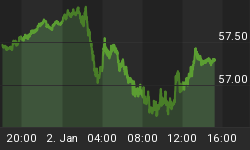As our economic ship continues to spring leaks, the goldilocks crowd still clings to the false belief that the Fed can easily keep us afloat with a few more rate cuts. This comfort has sustained many upbeat forecasts despite overwhelming evidence of an unfolding economic and monetary catastrophe of historic proportions.
On Monday we learned that Merrill Lynch, having just sold a $4.5 billion stake to the Singapore government, is again passing around the hat, this time wooing the Chinese and Saudi governments for badly needed funds. This of course follows similar moves by U.S. investment houses Citigroup, Morgan Stanley and Bear Stearns. These developments should be disconcerting on many levels, yet most seem unperturbed.
In the first place, the fact that troubled firms need to look abroad for cash provides startling evidence of the extent of the deterioration of America's economic might. The reason we need to seek capital from abroad is that we squander our own on consumption.
However, these foreign investments come at great cost; specifically preferred shares that place new foreign shareholders in senior positions to existing American shareholders and burden the latter with substantial dividend payments (11% for Citigroup and 9% for Morgan Stanley). Of course, large dividend payments to foreign shareholders will only worsen our nation's current account deficit, putting more downward pressure on the dollar and the American standard of living. Contrary to Wall Street's positive spin of foreigners "investing in America," such acquisitions really amount to foreigners buying up America, as our creditors take our assets in exchange for our debts.
On Wednesday we learned that the December ISM Manufacturing Index plunged to 47.7, its lowest level in nearly five years. The news sent the dollar swooning, gold and oil soaring, and pushed the Dow Jones to its largest point drop ever on the first trading day of a new year (in percentage terms the second largest drop since 1932). The report amounted to a stunning repudiation of the hope that the U.S. will export its way out of a coming recession. If manufacturing is at a five year low, how can exports be booming? After all, we can not export what we do not make -- unless of course we simply export used goods, which eventually we will be forced to do. However, selling used cars to the Chinese will not create many new jobs here; as all that need be done is load the vehicles on ships and wave goodbye. This is hardly the export boom Wall Street has championed as our economic savior, offsetting the negatives of housing, financials and the consumer.
Weakness in manufacturing was further confirmed today, with the release of a very weak December jobs report that revealed a loss of another 31,000 manufacturing jobs. Anemic job growth (over-all payrolls increased by only 18,000) coupled with an increase in the unemployment rate to 5% sent stocks and the dollar tumbling. The stagflation bell is ringing load and clear, if only Wall Street had enough sense to listen.
Additionally, despite Wall Street's vehement denials, evidence of run-away inflation continues to appear. The minutes of the Fed's December 11th meeting, which discounted the risks of inflation, conveniently validated this misconception. Wall Street of course denies the obvious that such forecasts merely reflect the Fed's campaign to dampen inflation expectations and not an honest assessment of actual inflation. Today on CNBC, Mark Zandi, the highly-respected chief economist of Moody's Economy.com, proclaimed that the falling dollar "has nothing to do with inflation". Since a weak dollar is the very essence of inflation, this asinine statement is on par with the "permanent plateau" comment uttered by Irving Fisher on the eve of the 1929 stock market crash.
Along those lines, Wall Street continues to buy into government propaganda designed to confuse the public about the true cause of inflation. They dismiss rising prices as resulting from economic growth and then minimize the impact by relying on bogus CPI statistics. This completely misses the point that legitimate economic growth causes prices to fall and not to rise. True economic growth comes from increased production, which lowers consumer prices by increasing supply, particularly for basic necessities such as food. The reality is that despite some genuine economic growth abroad, governments are creating so much inflation that food prices are raising anyway.
Finally, Wall Street takes solace in the fact that long-term interest rates on U.S. Treasuries apparently reflect a benign outlook for future inflation as well. However, today's high bond prices are more a function short-term bets being placed by leveraged speculators and central bank buying, not the rational expectations of long-term private investors. Rather than reflecting quiescent inflation, low long-term interest rates result from a bubble in the bond market. When it bursts, the true rate of inflation, as reflected in the relentless run up in gold prices, will finally be priced in.
In the meantime, with $100 oil, $850 gold, and beans in the teens, Wall Street still feels the Fed has the green light to keep cutting interest rates. Unfortunately on this point they are right. Rather than raising rates on its own terms and dealing with the consequences, the Fed will instead wait for a true financial crisis to emerge, at which point it will be forced to raise rates on the much more draconian terms imposed by our foreign creditors.
For a more in depth analysis of the inherent dangers facing the U.S. economy and the implications for U.S. dollar denominated investments, read my new book "Crash Proof: How to Profit from the Coming Economic Collapse." Click here to order a copy today.
More importantly, don't wait for reality to set in. Protect your wealth and preserve your purchasing power before it's too late. Discover the best way to buy gold at www.goldyoucanfold.com, download my free research report on the powerful case for investing in foreign equities available at www.researchreportone.com, and subscribe to my free, on-line investment newsletter at http://www.europac.net/newsletter/newsletter.asp.
















